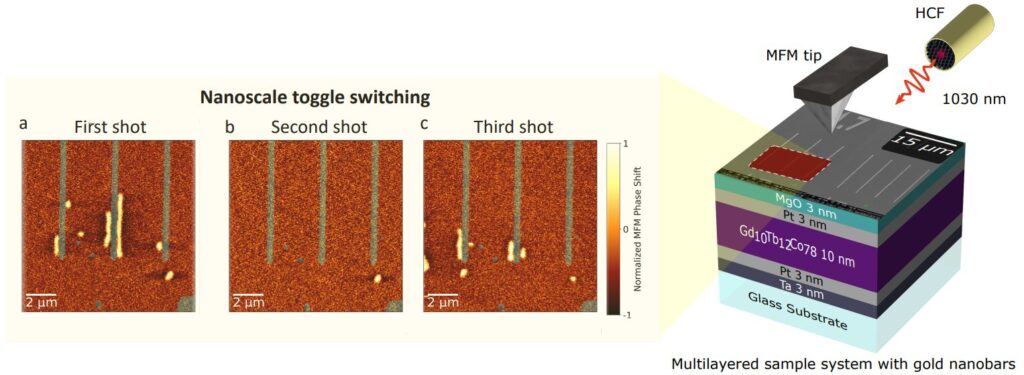Researchers from Max Born Institute have demonstrated a successful way to control and manipulate nanoscale magnetic bits—the building blocks of digital data—using an ultrafast laser pulse and plasmonic gold nanostructures. The findings were published in Nano Letters.
All-optical, helicity-independent magnetization switching (AO-HIS) is one of the most interesting and promising mechanisms for this endeavor, where the magnetization state can be reversed between two directions with a single femtosecond laser pulse, serving as “0s” and “1s” without any external magnetic field or complex wiring. This opens up exciting possibilities for creating memory devices that are not only faster and more robust but also consume far less power.
Ultrafast light-driven control of magnetization on the nanometer-length scale is key to achieving competitive bit sizes in next-generation data storage technology. However, it is currently not well understood to what extent basic physics processes such as heat transfer at the nanoscale and the propagation of magnetic domain walls limit the minimum achievable bit size.
To investigate these open questions, the researchers used plasmonic gold nanostructures, which can confine light to regions smaller than the wavelength of light. These structures were fabricated in-house by electron beam lithography on a 10 nm thin film of a magnetic material composed of rare earth—transition metal alloy (GdTbCo), capable of facilitating small stable magnetic domains due to the presence of the rare earth metal terbium, generating a large magnetic anisotropy.
-

All optical switching from off- and on-resonant nanodiscs. Credit: T.P.H. Sidiropoulos, P. Singh
-

Inside view of the MFM chamber highlighting the opto-mechanical setup guiding the laser beam towards the sample. The HCF is connected to an optical cage system mounted on a 3D printed adapter for the MFM head. Light emitted from the fibre is collimated by lens (L1) and focused onto the sample by a second lens (L2). The polarization on the sample is controlled via half-wave plate (P). Credit: Nano Letters (2025). DOI: 10.1021/acs.nanolett.4c04024
Using a 370 fs ultrashort laser pulse of 1030 nm wavelength, magnetic switching was achieved in areas with a width of only 240 nm. The nanostructures also reduced the pulse energies required, due to the enhanced localization of the electromagnetic field around the gold bars, exploiting their plasmonic property.
Illumination with single laser pulses can be used to locally switch the magnetization at the edge of the nanostructure. Furthermore, a region where the magnetization has been switched by the laser pulse can be reverted with another single laser pulse at precisely targeted locations on the magnetic material.
It is thus possible to realize a controlled toggling of the magnetization, as required to encode information states “0” and “1.” The final magnetic state was visualized using magnetic force microscopy (MFM), a scanning technique that can image the magnetic state of a sample with nanometer-scale spatial resolution.
In addition to the demonstration of toggle switching, under particular laser pulse conditions, the researchers observed interesting extended magnetization patterns. When exciting under conditions where the nanostructures do not allow for a plasmonic resonance to be excited by the laser, a dipole-like far field scattering domain pattern is “imprinted” in the magnetic film. Via on- and off- resonant plasmonic excitation, the dominance of different plasmonic energy transfer mechanisms could be studied.
“While this is basic research on the fundamental processes of localized optical switching of magnetization, it may guide future developments towards optimized excitation schemes in engineered magnetic materials, ultimately allowing to exploit nanoscale control of magnetism using light,” says Puloma Singh, an MBI researcher driving this project together with her MBI colleagues as part of her Ph.D. studies.
Provided by
Max Born Institute for Nonlinear Optics and Short Pulse Spectroscopy (MBI)


